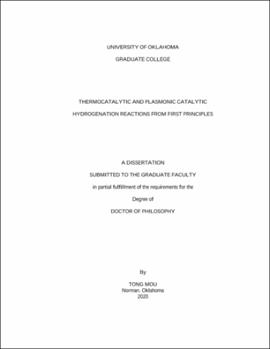| dc.description.abstract | As the world is facing post-climate change situation and the escalating demand of energy, a gradual energy transition from fossil fuels (oil, coal, natural gas) to renewable energy technologies (natural resources such as biomass, solar, wind) is inevitable and essential. Solar energy, as the most abundant, safe and clean energy source among all available renewable energy technologies, has prospective potentials as future power generators. However, although significant progress has been made, the electricity generation from sunlight in commercial photovoltaic (PV) solar cells still suffer from low energy conversion efficiency and high cost. In addition, due to technological difficulties associated with the rapid electron-hole recombination in photocatalysis systems, realizing commercial implementations of photocatalytic systems remains a challenge.
In this dissertation, a thorough first-principles analysis was performed on three hydrogen-involving processes, including solar to electricity, catalytic hydrotreating and solar to chemical conversion processes. By investigating their thermodynamic and kinetics properties, we aim to bridge solar energy utilization with chemical energy production under ambient conditions.
We begin with the discussion of nitrogen-related defects in a dilute nitride material GaInNAs, which shows promising candidacy as the fourth junction in multijunction solar cells. While the photoluminescence spectra presented remaining defects in the hydrogenated alloy, first-principles calculations revealed the thermodynamic limitation of hydrogen addition on the In-N complexes. Next, a comprehensive kinetic study on cyclohexene hydrogenation reaction on palladium and palladium hydride surfaces were conducted, through a combination of experimental and theoretical work, which laid foundations for later study of plasmonic hydrogenation reactions. In light of thermodynamic and kinetic studies addressed earlier, we undertake investigations on plasmonic catalytic hydrogenation of 4-nitrophenol on gold surfaces. We measured the catalytic activity with and without light irradiation and observed higher reaction rates under light. A theoretical correlation between rate enhancements and reaction energy barrier reduction was constructed via density functional theory calculations. Moreover, we propose that the reaction can be further enhanced over a hexagonal boron nitride (h-BN) layer supported on Au in an Au@h-BN core-shell structure. In this dissertation, we attempt to understand the electron behavior at atomic level, through the investigation of hydrogen-involved processes. Moreover, by discussing efficiency improvement options, we attempt to guide the future design of plasmonic catalysts. | en_US |

